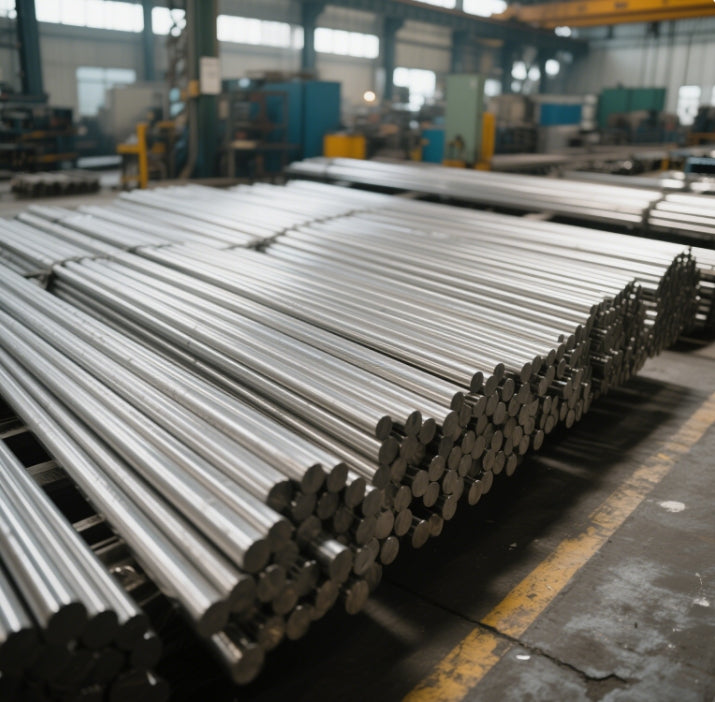StockSteel
Stainless Steel Rod Guaranteed | 100% Quality Assurance
Stainless Steel Rod Guaranteed | 100% Quality Assurance
Couldn't load pickup availability
Stainless Steel Rod Guaranteed | 100% Quality Assurance
Product Specifications
| Parameter | Details |
|---|---|
| Material Grades | 304L, 316L, 2205 Duplex, 17-4 PH (Customizable for closet rod stainless steel or best brazing rod for stainless steel) |
| Diameter Range | Round Rods: 6–500mm; Threaded Rods: M6–M30; Brazing Rods: brazing rods for stainless steel (1.6–6.0mm) |
| Length | 0.1–12m (Standard), Custom Lengths Available (±0.1mm Tolerance) |
| Hardness (HV) | 150–250 HV (304L/316L); 300–400 HV (Cold-Worked/Duplex Grades) |
| Tensile Strength | 485–860 MPa (304L); 800–1,200 MPa (Duplex 2205); 700–1,000 MPa (17-4 PH) |
| Surface Finish | Polished (#4–#8 Mirror), Passivated, Cold Drawn, Electroplated (Optional) |
| Certifications | ISO 9001, ASTM A276/A312, EN 10088, NACE MR0175 (H₂S Resistance) |
| Delivery Options | Global shipping via DHL/FedEx; bulk discounts for orders >5 tons |
Mechanical & Chemical Properties
Tensile Strength
The best brazing rod for stainless steel (ER316L grade) achieves tensile strengths of 860 MPa, ideal for high-temperature applications like heat exchangers or chemical reactors. Closet rod stainless steel (304L grade) balances strength (485–860 MPa) with corrosion resistance for humid environments like bathrooms or marine closets. Duplex 2205 rods combine austenitic-ferritic microstructures to deliver 1,200 MPa tensile strength, outperforming standard grades by 40% in chloride-rich settings like coastal infrastructure.
Bend Strength
Bend strength ranges from 60–75% of tensile strength, optimized for dynamic loads. Brazing rods for stainless steel (ER309L) exhibit 30% higher bend resistance than standard fillers, critical for joints in HVAC systems or food processing equipment. Cold-drawn 316L rods retain bend resistance up to 430 MPa, ensuring structural integrity in seismic-resistant architectural frameworks.
Identification & Marking
Stainless steel rods are labeled per global standards for traceability:
- ASTM A276: Specifies chemical compositions (e.g., 316L: 16–18% Cr, 10–14% Ni, 2–3% Mo).
- ISO 15510: Ensures compliance for marine and medical-grade applications.
- Laser Etching: Permanent markings include grade (e.g., "316L-860MPa"), batch number, and tensile class.
Weight Calculation
Weight (kg) = Volume (m³) × Density (7,930 kg/m³ for austenitic steel; 7.65–7.80 g/cm³ for martensitic grades).
Example for a 12mm diameter, 1m rod (304L):π × (0.006m)² × 1m × 7,930 kg/m³ ≈ 0.89 kg.
For closet rod stainless steel (16mm diameter):Weight ≈ 1.58 kg/m. Custom weights vary with alloy density and surface treatments.
Why Stainless Steel Rusts: Causes & Solutions
While stainless steel resists corrosion via chromium oxide layers (≥10.5% Cr), specific conditions trigger rust:
- Chloride Exposure: Coastal saltwater or de-icing salts degrade passive layers. Use 316L rods for best brazing rod for stainless steel in marine settings.
- Galvanic Corrosion: Contact with carbon steel accelerates oxidation. Insulate joints using dielectric coatings or ER309L fillers from the brazing rods for stainless steel series.
- Mechanical Damage: Scratches expose iron. Passivate surfaces with nitric acid post-machining to restore chromium oxide layers.
- Low Oxygen Environments: Stagnant water in crevices (e.g., threaded joints) breeds crevice corrosion. Design gaps >0.5mm for oxygen flow.
Why Choose Our Stainless Steel Rods
- Certified Quality: ISO 9001 and ASTM-compliant production with third-party SGS/BV inspections.
- Precision Customization: Tailor closet rod stainless steel, brazing rods, or threaded rods to ±0.1mm tolerance.
- Fast Delivery: Bulk orders shipped globally in 15–30 days via DHL/FedEx; urgent regional orders fulfilled in 3–7 days.
- Sustainability: 100% recyclable alloys; lean duplex grades reduce nickel consumption by 50%.
- Technical Support: Expert guidance on welding parameters (e.g., ER316L preheat: 150–200°C) and corrosion prevention.

